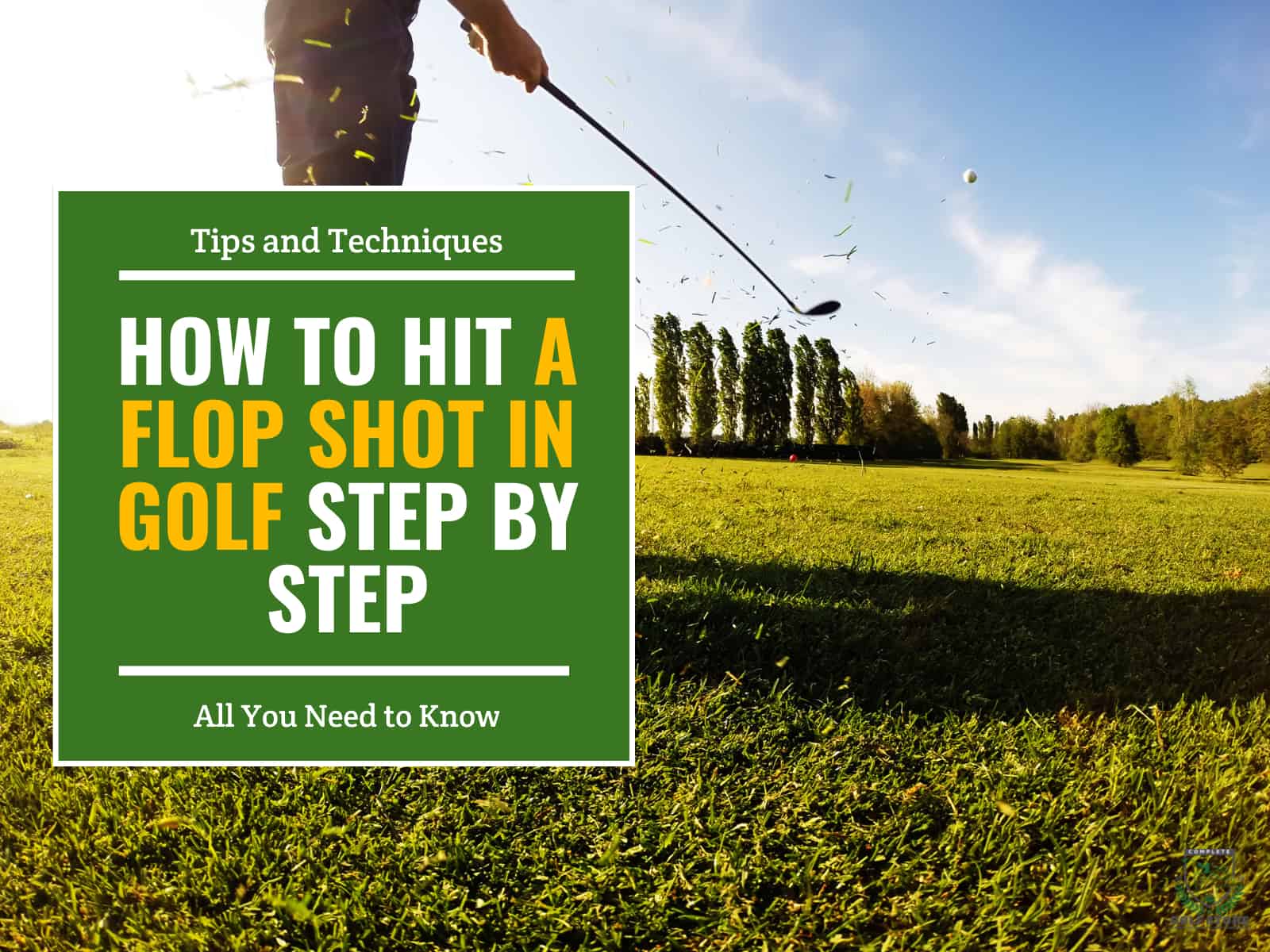With the ease of obtaining golf equipment today, anyone can learn and master the game. At first glance, it may seem easy to play and master, but once you decide to take it up, you start to see how technical and challenging it is.
The golf swing is the most critical part. How you swing your club affects the whole game, from the ball’s trajectory to the outcome. Mastering your swing is the first step toward becoming a better golfer.
We will provide golf swing basics, tips for beginners, advice on what you need to work on, and a list of common swing mistakes that most beginners make.
YOU SWING YOUR BEST WHEN YOU HAVE THE FEWEST THINGS TO THINK ABOUT.
~ Bobby Jones
What Is the Perfect Golf Swing?
The concept of a “perfect” swing is subjective and can vary from player to player. Golf swings can be effective and successful even with slight variations in technique. However, there are key elements that many professionals and instructors consider important for a solid and repeatable swing.
These fundamentals include elements like proper alignment and setup, a correct grip, good posture and balance, and a smooth tempo and rhythm to go through different swing stages: backswing, downswing, impact, and follow-through.
The swing stages will be explored in more detail below; as for alignment and setup, they simply mean getting ready for your shot. Grip refers to the way you hold your club, which greatly affects your entire game and results. Posture and balance refer to your stance and weight distribution during the swing.
Tempo (rhythm) refers to the ratio of your backswing time to your downswing time; i.e. how much time you take to backswing relative to the downswing movement. We do have a detailed guide on the Golf Swing Tempo in case you want to know more about how important it is to your game.
Make sure that you stand with your feet apart (width of shoulders) while keeping your back straight. The weight should be placed on the inside of the feet at this point. For a stable hold of the club, you can also bend your knees slightly. This also helps improve your posture and prevents straining your back. With this, your grip on the club also gets better.
Do not worry if you still have trouble understanding what is being discussed here! We will be covering everything in more detail in the upcoming sections.
Golf Swing Basics: Step by Step
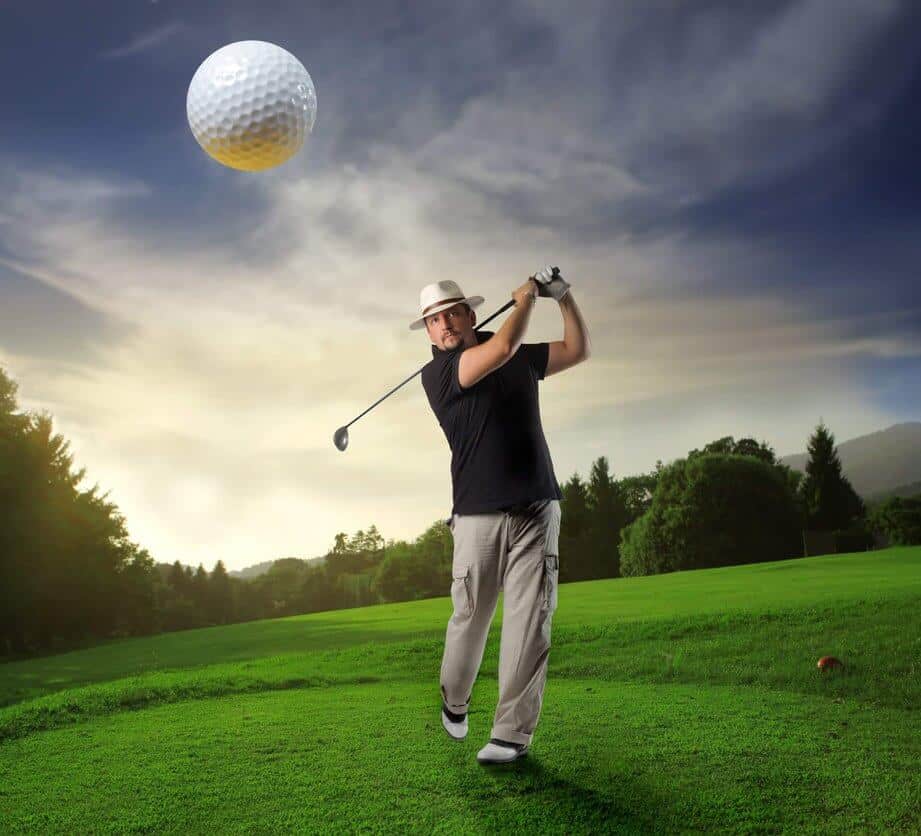
Learning the many components lets you know which ones to target and which ones to ignore. There are some flaws in the swing that beginners struggle with. Correcting each swing flaw begins with working on the specifics of your technique.
Let’s go through each swing stage individually.
Step 1: Getting in Position
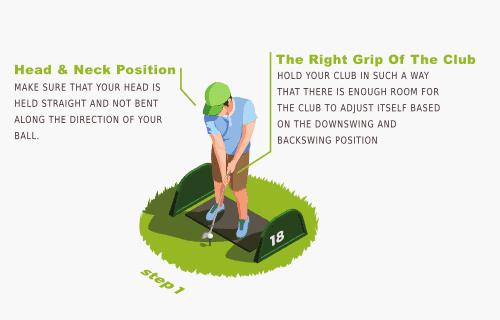
This is usually referred to as setup, and It simply means getting ready for the swing. Usually, the setup includes two main parts: stance and posture. Please note that most of the examples and explanations provided concern right-handed golfers; it will be the opposite for lefties.
Golf posture means standing up straight while holding the club properly at waist level and tilting forward using the hips. The shoulders need to stay down and the back straight until after the ball has been hit. This will help keep the body balanced during the swing.
In this short video (1 minute 20 seconds), Martin Hall from SwingpalAcademy talks about the correct golf posture.
Stance refers to how the feet are positioned vis-à-vis the target line (and each other). It also determines whether the left foot goes before the right one (closed stance) or vice versa (open stance).
When the toe line is parallel to the target line, this is called a ‘square stance’, which is more likely to leave the loft of the club unaltered. An open stance can increase the loft of any used club, making the ball fly higher, while a closed stance means a lower loft than what the club was initially designed for.
Getting in the proper position (with the correct posture and stance) is crucial. In case you stand too far away from the target line, you’ll likely miss out on hitting the center of the fairway. On the contrary, if you don’t step back enough, you won’t get as much power behind the shot.
When it comes to pressure and weight, most amateurs place more pressure and weight on their trail foot, specifically on the heel during setup. On the other hand, most tour players adopt a totally different (almost opposite) approach by placing more weight and pressure on the front foot between the ball of the foot and the toes.
Step 2: Grip Your Golf Club Properly
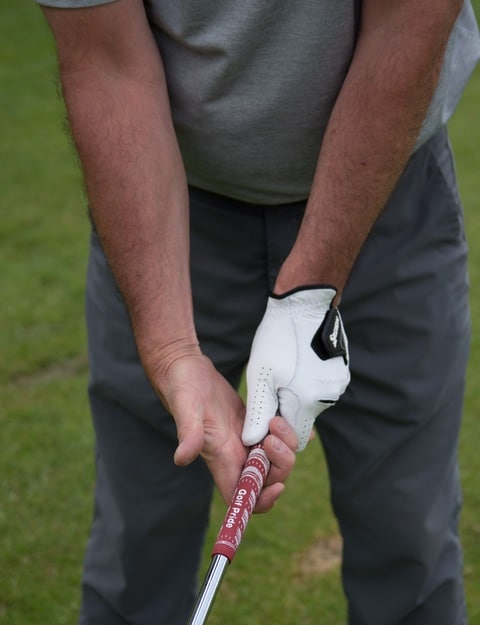
The grip refers to where your hands should be on the club when swinging it. You want to have both hands close together so that there isn’t any space between them. The lead hand should be on the top of the club, with the trail (dominant) hand immediately underneath it.
This allows you to get maximum power from the swing. If you don’t have a proper grip on your club, you’ll lose some distance from your shots and may end up with all sorts of problems.
A good way to check if you are gripping the club correctly is by looking at the back of your fingers and thumb. They should look like they’re touching each other but not overlapping (which is a different grip called “an overlapping grip” [2]).
You also need proper grip pressure. The hands should hold the club comfortably but securely, with both the left and right hands working together in unison.
Depending on where your hands are facing while holding the club, you can have a strong, weak or neutral grip.
- A strong grip refers to a hand position where the hands are rotated more to the right (for a right-handed golfer) on the club. This means that the “V” formed between the thumb and forefinger of each hand points more toward the right shoulder or even beyond. A strong grip can promote a closed clubface at impact, which may lead to draws or reduced slices.
- A weak grip is the opposite. The hands are rotated more to the left. This means that the “V” shape points more toward the left shoulder. A weak grip can lead to an open clubface at impact, potentially resulting in fades or slices.
- A neutral grip is a balanced hand position. The “V” shape points toward the center of the body. This grip promotes a more consistent and square clubface at impact, providing a good foundation for straighter and more predictable shots. This is the recommended grip for most beginners for developing a consistent swing.
There are also other types of grip based on how your hands interact with each other: Interlocking, Vardon and Ten Fingers. To know everything, we invite you to dedicate some time to going through our detailed guide on how to hold the golf club.
You could also watch this short video (1 minute 45 seconds) from the Golf Channel where Michael Breed teaches proper golf grip.
Step 3: How to Aim in Your Golf Swing?
It is always recommended to take enough time while aiming. You need to focus on where you want the ball to go rather than try to aim directly at the hole. Instead, try to align yourself so that the path of the ball takes you toward the intended landing spot.
Many professional golfers pick intermediate targets; that is, instead of choosing a target that could be hundreds of yards away, they can use a closer intermediate target that is on the line between the ball and the selected target.
If your shot is going left or right (causing hooks or slices), then adjust accordingly and make sure you are not hitting the ground first with a full backswing (causing a fat shot).
Also, many players make the mistake of aligning their feet near the ball before placing the club and squaring its face. Most professionals would agree that it’s always better to start by squaring the clubface before placing the feet.
Chris Ryan, a PGA professional, provides useful tips to help golfers aim correctly in this video (6 minutes 42 seconds) from ChrisRyanGolf‘s YouTube channel.
Backswing
During your swing, the takeaway starts as the club moves away from the ball and ends when it is parallel to the ground. From there, the backswing begins. It’s crucial to have a smooth takeaway for better results.
Correcting the backswing is essential, especially for beginners. One common mistake is moving the hands too far away from the body. The proper backswing involves keeping the strong arm (the one below on the grip) close to your body. This ensures an efficient transfer of energy and avoids straining your shoulder bone.

For a more natural swing, keep your hand close to the body and then swing the club backward. Your weight should shift to your right foot if you are a right-handed player. Once you master this technique, try it on an empty course or practice area where there will not be anyone else around.
If you feel comfortable doing so, take some lessons at a local golf school. You can also ask your instructor about what they think would work best for you.
The key here is to make sure that your hands stay in contact with each other throughout the entire movement. Also, ensure that they remain on top of the shaft through the backswing until the club comes into contact with the ball.
You also need to ensure that your left arm is straight and that your right heel remains on the ground throughout the entire backswing. Also, the right knee should be bent a little, while the left knee must be facing toward the ball.
Finally, the hips and shoulders need to rotate during the backswing (without sliding); if you fail to do so, the result will be an “all-arm swing” which doesn’t adequately prepare the body for impact and may cause injury.
What better way to have the perfect backswing than watching a video (02 min. 51 sec.) where David Leadbetter teaches the technique on Golf Digest’s Channel; He’s one of the most popular golf instructors:
Downswing & Impact
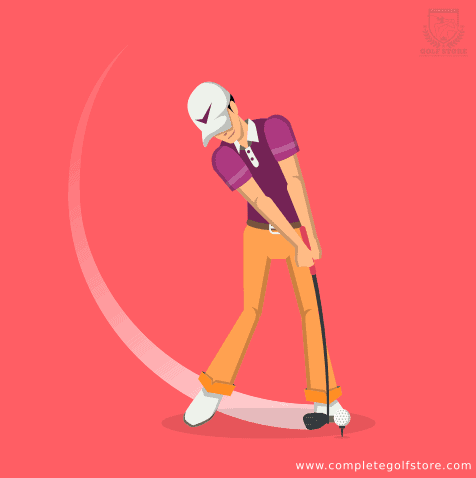
Once your backswing motion is over, the next move is where the club head starts moving down toward the ball. This is the other major part of the swing where the slightest changes can dampen your swing style.
It’s important to remember that the speed of the clubhead does not change much after the initial forward momentum has been established. So once you’ve got your stance set up correctly, focus on maintaining a good balance between your feet. Then concentrate on keeping both knees slightly bent. As long as these two things happen, everything else falls into place.
It is of utmost importance for your hips to move (or uncoil) before the shoulders and arms during the downswing. Also, the hips must not slide sideways while down swinging and the bodyweight transfers progressively to the left foot as the club comes down. What follows is impact, and there are things to remember there, too.
The impact position is all about getting into the correct hitting zone at the moment of contact with the ball. If you don’t get this part right, you won’t make solid contact with the ball through impact.
For instance, a righty must have most of the bodyweight (about 80%) on the left side of the body and more pressure on the left foot, and the right heel must start to lift while keeping the eyes on the back of the ball and the hands forward of the ball at the moment of impact.
In the following video (6 minutes), Jim McLean and Martin Hall discuss and teach the techniques of a good downswing.
The Follow-Through
Once your clubhead impacts the ball, your swing doesn’t end. You cannot abruptly stop your club once you hit the ball. Not giving enough importance to the follow-through can result in deceleration or blocking issues.
If you aim for natural rhythm and getting the best shot, you should also slightly move the club forward so that you extend your arms straight and forth.
Once your swing is complete, your knees become straight again. Another characteristic of the follow-through would be the shoulder falling downward with your hands extending forward.
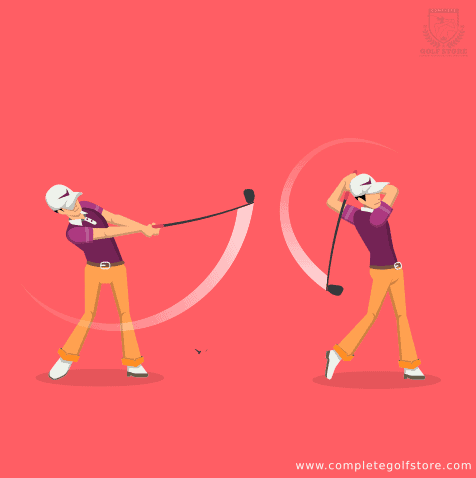
Keep your upper body upright and balanced during the follow-through by shifting your weight onto your lead leg. Your lower half should remain relatively still throughout the entire swing.
This means that your torso remains straight and level, and your head stays steady. During the follow-through, your spine should remain erect and aligned with your shoulders.
Your legs are the foundation of any great swing; they provide stability when swinging and allow for a quick and efficient weight shift. When executing a proper follow-through, your legs work together to propel you forward.
They also serve as shock absorbers to protect against injuries caused by jarring collisions with the ground. In addition, your legs give you support and traction when making powerful swings.
Nick Faldo provides tips on the follow-through in the following video (2 minutes 35 seconds) from Golfing World‘s YouTube Channel.
The combination of the ideal backswing, downswing, and follow-through comes from the proper weight distribution of your body as well. This helps improve your stability as well as the strength of your shot.
Most Common Golf Swing Mistakes To Avoid
With all the moving parts in a golf swing, many things can go wrong, even with proper determination and focus, there are a lot of common mistakes even the average amateur can make:
Mistake #1: Arms Too Straight
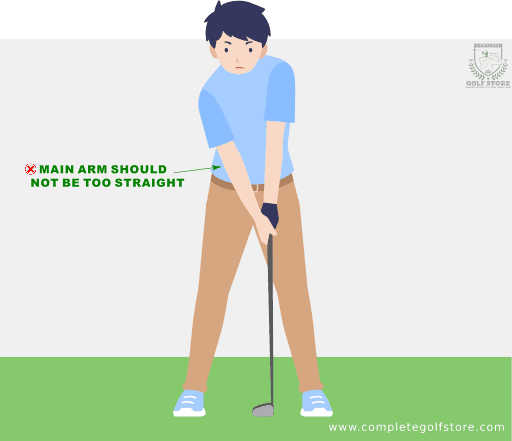
When your right arm is too straight as a right-handed player, you feel hand and shoulder joint pains too soon. The key is to know which arm to flex and which one to hold straight to perfect your shot. For right-handed players, the right hand should remain slightly flexed with the left hand straight.
When your arm feels too tight and straight, it leads to less control over the club. As a result, you feel like your swing works poorly. For a free movement and natural swing direction, you need your right hand to hang free. Keep your back firm but your hands loose while your right hand also stays close to the body.
Mistake #2: Too Strong Grip
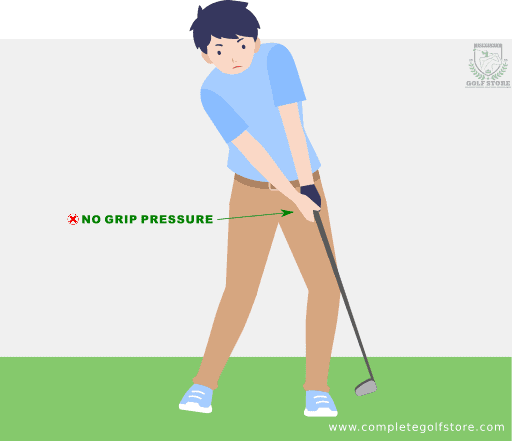
Just the right grip of the club can impact the swing positively. Holding the club in such a way that your palms overlap might lead to too much tightness in the grip. With this, even when you swing right, there is not enough momentum in your swing.
This leads to less ball speed even after a powerful strike. To prevent this, you need to work on your grip. The type of club grip installed has a considerable role to play in your grip and, therefore, your swing as well.
Ensure that you hold your club so that there is enough room for it to adjust itself based on the downswing and backswing position. It would be best if you also did not strain your wrist due to a wrong grip. At a fast swing rate, you might hurt your wrist if you apply too much pressure on it. Drivers and woods tend to have a tiny loft on the clubhead. With such clubs, a wrong grip can have a huge impact.
Mistake #3: Bending Your Knees Too Much Or Too Little
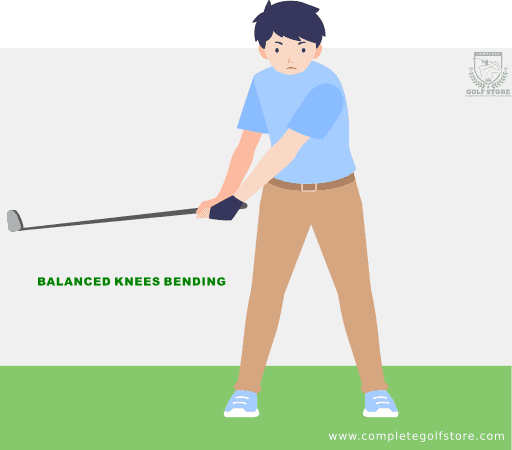
Keeping your legs straight or bending the knees too much can hurt your swing style. It should not deviate too much so that your shoulders drop too low. With this, your club is automatically extended farther away, leading to an outward hit on the ball and taking it in a different path than expected. It would help if you bent your knees a little, especially during the downswing and backswing (without overdoing it).
The key is to get the shot right and make the best contact with the ball. For this, your swing should work such that your knees are just a little bent. The right knee bends at the backswing, and the left bends a bit at the downswing.
Once you are done with the impact, your left knee goes back to the original position and gets straight.
Mistake #4: Bending Your Shoulders Too Much On The Front
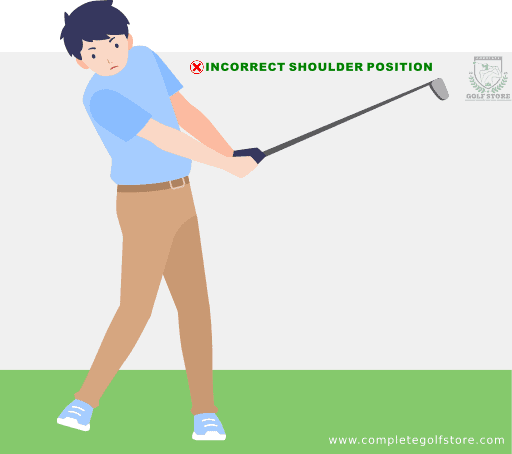
For the sake of feeling a more balanced posture, many golfers tend to bend their shoulders forward. This leads to the light hump of the spine, which in turn can lead to a bad hold of the club.
The problem can be with your shoulder position. This can be easy to correct, even as a beginner. Ensure that you check your posture on the range before working on any other aspect of your game. From the swing speed to the angle of impact, you can change everything by slightly altering the position of the shoulder itself.
Another problem here could be that it would be difficult to rotate your arms with shoulders leaning too much to the front. If you need speed and power in your swing, then you need your hands to rotate fully under your control. For this, you should stop hunching your shoulders forward.
Mistake #5: Sinking Your Head Too Low
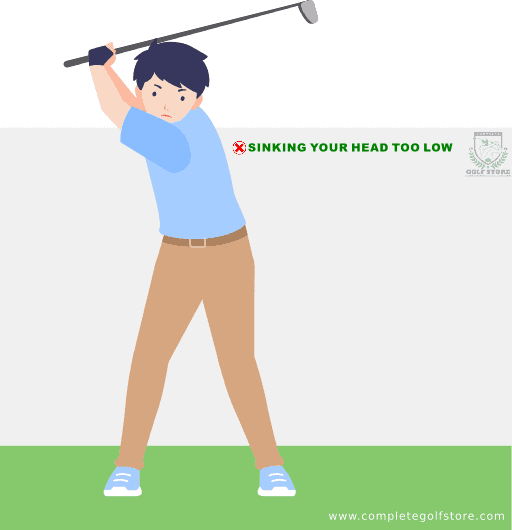
Just like bending the shoulder, looking down such that your neck and head are bent towards your chest is another common mistake that should be avoided. You might be keenly focusing on the shot and the ball that you might miss the rotation part.
To prevent this, you should keep your spine erect. Keep your chin high and away from your chest for a better posture. If you want to play like a pro and swing like a pro, make sure that your head is held straight and not bent along the direction of your ball.
Mistake #6: Picking The Wrong Club Type

Besides the direct influencers, other factors can alter your swing. When you choose the wrong kind of clubs, you end up with a poor shot, even with the right swing style. Make sure that you understand the function of each club and pick the right one for each shot.
Not all clubs are the same, and not all clubs give you the same ball flight and distance. So, even if you have perfected your swing, before any competitive match, you should make sure that you try out all your clubs before you play.
You may read our article about different types, components and uses of golf clubs to know exactly which club to use and when.
Frequently Asked Questions
In this section, we will be trying to answer some of the most commonly asked questions about golf swings in order to make sure you are ready for your golfing adventure.
What Is the Golf Swing Plane?
The swing plane is the imaginary line the clubhead travels on during the swing that separates the end from the start of the swing. It’s a very important concept to understand in your golf swing, especially if you’re trying to improve it. It is a reference point that helps you to understand how your body moves during the swing. It’s also called “the center of gravity line” or “swing path.”
As a beginner, the swing plane can help you with :
• Understanding where your weight should go.
• Knowing when to release the hands after impact.
• Identifying whether your shoulders are too high or low.
• Figuring out what kind of grip pressure you need.
• Getting comfortable with different types of swings.
How to Practice the Swing Takeaway?
To practice takeaway, you must first learn how to properly take away without losing your balance. This will allow you to have better control over your body throughout the entire swing. The best way to do this is through proper alignment.
If the posture is good, you are off to a good start. After that, you always need to make sure that the club shaft is parallel to your toe line at the end of the takeaway. Finally, you want the toe of your clubhead to be pointing to the sky. These three components will ensure that your takeaway and overall swing will be better.
One simple trick to check everything is correct was introduced by Ashley Mayo, the director of Golf Brand and senior editor at the Golf Digest magazine. The drill consists of doing normal practice swings (at a driving range for example); when the club reaches the end of the takeaway, pause to check that the club is in the correct position (shaft parallel to toe line and clubhead toe pointing to the sky). Then, you proceed with the swing. All it takes is a slight pause to make sure everything is correct.
How Do Beginners Learn the Golf Swing?
There are many ways to teach someone how to play golf. However, there are two main methods: 1) learning the basics of the swing; 2) teaching them how to execute their own swing.
Learning the basics of the swing involves understanding its basic mechanics. For instance, knowing about the importance of having an open stance, keeping the spine straight, maintaining eye contact with the target, etc., all contribute to making a great swing. Once these fundamentals are mastered, they can be applied to any type of shot.
On the other hand, teaching people how to execute their own swing requires more than just explaining the mechanics. In order to achieve success on the course, players need to know how to apply those principles to their game. This usually requires a lot of time and patience. Getting results may require some trial and error. There are no shortcuts here.
It also helps to understand the physics behind the swing so that one can apply those principles to the course. The most important thing to remember is that everyone has a unique swing style. For instance, some players prefer to keep their arms close to their bodies, while others like to use more space between their arms and torso.
What Is a Birdie in Golf?
The term ‘birdie’ means scoring a single stroke lower than the announced par of a hole. In other words, a golf player scores a birdie if he/she only consumes two strokes to finish a par-three hole or finishes a par-four hole using only three strokes. It can be achieved with any given hole as long as you score one stroke lower than the par. An experienced golfer would agree that birdies can be achieved with a lot of practice, work, determination, and luck!
Historically speaking, it is widely believed (though not proven) that the term birdie was first used during the nineteenth century (and the beginning of the twentieth). During that time, the word ‘bird’ could be used as a synonym for ‘cool’. So, the term came to be used in golf slang to refer to an excellent result.
Is the Golf Swing a Push or a Pull?
Well, the answer to this question depends on what kind of swing you want to have. For pitch and chip shots, you normally rely more on the trail arm to swing. These types of shots are pull/push mainly using the trail arm, while the lead arm is usually not needed much. Using a driver is also a pull/push, but this time the player relies on both arms (trail and lead) equally to push and pull and generate the amount of force necessary to drive the ball for a long distance.
If you ever watch any videos of a professional golfer like Tiger Woods hitting a drive off the tee box, you will notice how he uses his trailing arm to propel the club forward but then turns around quickly to follow through with his leading arm. Tiger keeps his eyes focused on the ball until after impact. That tells us that Tiger relies mostly on his trailing arm to generate power during the backswing and then switches to his leading arm to control the direction of travel once the clubhead reaches its peak position.
Wrap-Up
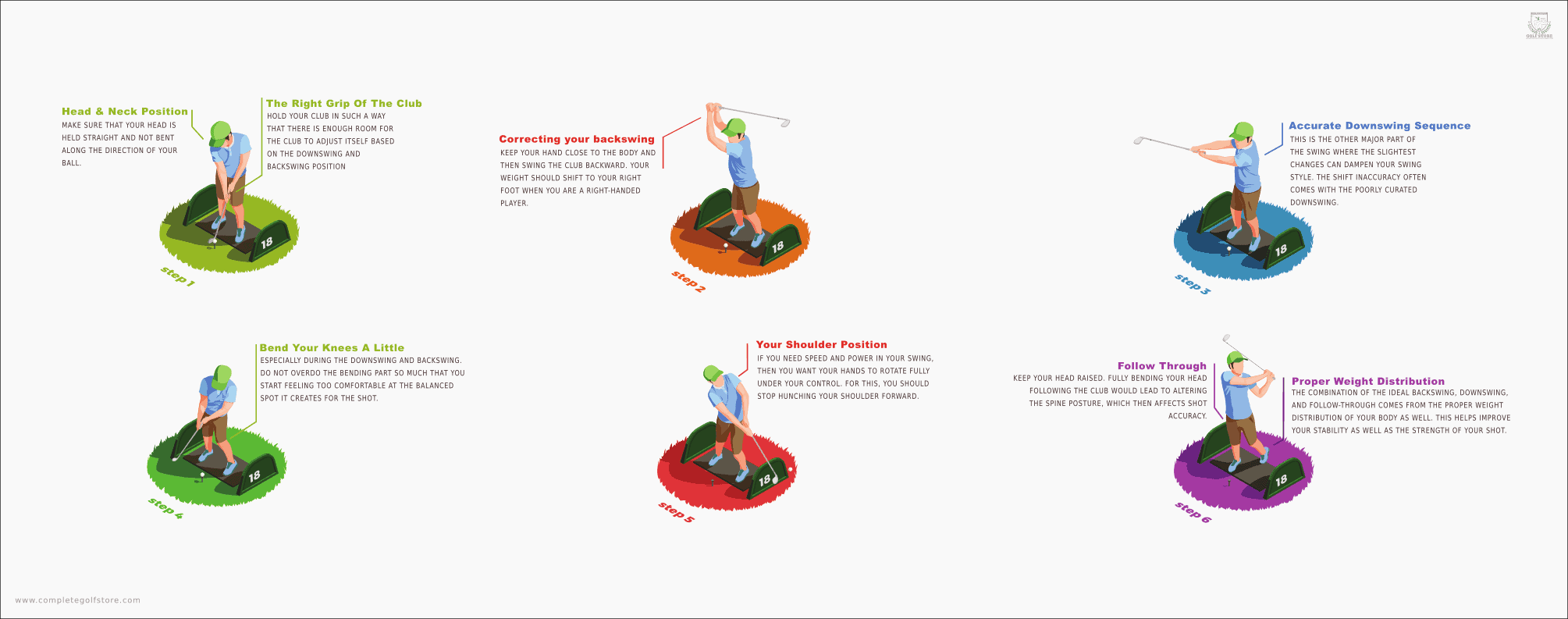
Who could have guessed that the golf swing would be one of the most popular topics on the Internet?
In this article, we tried to cover the topic of golf swings in detail, giving plenty of explanations and advice to help novice golfers get better. We believe that the golf swing is an iceberg; All you see is the golfer getting in position and swinging their club. It looks like a simple move that only takes a few seconds to complete, but there is a lot of science and technique behind it.
In the end, we believe that if you follow our tips and advice and regularly spend some serious practice time, you will be able to swing like a pro. After that, if you still need more help with your swing, check out our list of the Best golf swing training aids and tools that can help you perform better on the course.
References:
- Kinetic energy | Definition & Formula. In Encyclopædia Britannica. Retrieved from https://www.britannica.com/science/kinetic-energy
- Overlap grip. Merriam-Webster.com. https://www.merriam-webster.com/dictionary/overlap%20grip


